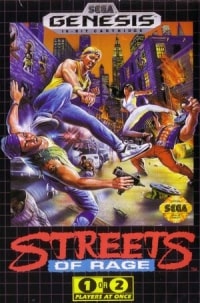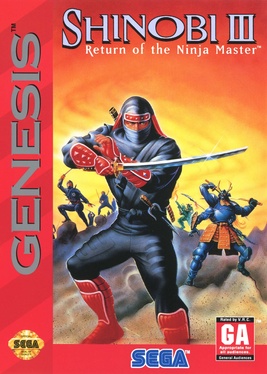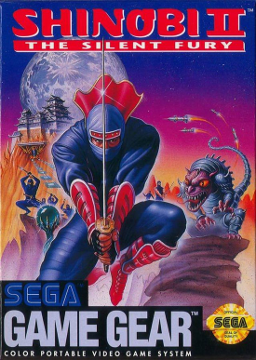
Sonic the Hedgehog is a 1991 side-scrolling platform game. It is a companion to the 16-bit Sega Genesis game Sonic the Hedgehog for the 8-bit Master System and Game Gear consoles. Ancient—a studio founded by composer Yuzo Koshiro for the project—developed the game and Sega published it to promote the handheld Game Gear. The 8-bit Sonic is a side-scrolling video game similar in style to the 16-bit game, but reduced in complexity to fit the 8-bit systems.

Shinobi (忍) is a side-scrolling hack and slash video game produced by Sega, originally released for arcades on the Sega System 16 board in 1987. The player controls ninja Joe Musashi, to stop the Zeed terrorist organization from kidnapping students of his clan.
Ninja Gaiden is a media franchise based on action video games by Tecmo featuring the ninja Ryu Hayabusa as its protagonist. The series was originally known as Ninja Ryukenden in Japan. The word "gaiden" in the North American Ninja Gaiden title means "side story" in Japanese. The original arcade version, first two Nintendo Entertainment System games and Game Boy game were released as Shadow Warriors in PAL regions. As of 2008, the series has shipped over 7.7 million copies.

Streets of Rage is a beat 'em up game developed and published by Sega for the Genesis in 1991. Players control one of three former police officers turned vigilantes who battle a crime syndicate. Streets of Rage establishes many conventions of the Streets of Rage series, such as two-player cooperative play and an acclaimed techno soundtrack from composer Yuzo Koshiro. It was ported for the Game Gear, Sega CD and Master System and has been rereleased as part of various compilations and on download services.

The Revenge of Shinobi, released in Japan as The Super Shinobi, is a hack-and-slash action video game developed and published by Sega in 1989. It was the first Shinobi game developed for the Sega Genesis, and was later released on the coin-operated version of that console, the Mega-Tech.

Shinobi III: Return of the Ninja Master, released in Japan as The Super Shinobi II, is a 1993 hack-and-slash platform game developed and published by Sega for the Mega Drive/Genesis. It is the direct sequel to the previous The Revenge of Shinobi. The game was intended to be released in 1992 and to be very different from the final version of the game in terms of levels and storyline. Shinobi III received critical acclaim. It's been ranked among the greatest Mega Drive/Genesis games.

Yuzo Koshiro is a Japanese composer and sound programmer. He is often regarded as one of the most influential innovators in chiptune and video game music, producing music in a number of genres including rock, jazz, symphonic, and various electronic genres such as house, electro, techno, trance, and hip hop.

Streets of Rage 2, known as Bare Knuckle II in Japan, is a 1992 side-scrolling beat 'em up video game published by Sega for the Genesis/Mega Drive. A sequel to Streets of Rage (1991), the characters Axel Stone and Blaze Fielding return while the game also introduces two new characters: Max Thunder, and Eddie "Skate" Hunter, the younger brother of Adam Hunter from the first game.

Shinobi Legions, known as Shinobi X in Europe and as Shin Shinobi Den in Japan, is an action game in the Shinobi series developed and published by Sega in 1995 for the Sega Saturn.

Shinobi is a 3D action-adventure video game developed by Overworks and published by Sega as part of the Shinobi series. It was released for the PlayStation 2 console on November 12, 2002, in North America; December 5 in Japan; and May 15, 2003, in Europe. The game stars the master ninja Hotsuma, leader of the Oboro clan, who wields Akujiki, a sword that feeds on souls. He can also use ninja magic, shurikens, and special moves. Upon finding a golden castle after an earthquake, Hotsuma makes it his goal to defeat the powerful sorcerer Hiruko, who had summoned hellspawn creatures in Japan to destroy Tokyo. Hotsuma's mission is to stop Hiroko from destroying the world and avenge the death of his clan.

Nightshade, released in Japan as Kunoichi and stylized in all regions with the kanji 忍 behind the title, is an action video game for the PlayStation 2 (PS2), developed by Overworks and published by Sega in 2003. It is the eleventh game in the Shinobi series and follows the exploits of a female ninja named Hibana. The game is a sequel to the 2002 PS2 game Shinobi.

The Cyber Shinobi is a side-scrolling hack and slash produced by Sega that was released for the Master System in 1990. It was the third Shinobi game for the console and served as a futuristic sequel to the original Shinobi. The game was released in Canada, Europe, Australia and Brazil, at a time when the Master System was discontinued in other markets.

The G.G. Shinobi (ザ・GG忍) is a side-scrolling action game by Sega released for the Game Gear in 1991. It was the first Shinobi game developed specifically for a portable game platform. The player controls the modern-day ninja Joe Musashi, protagonist of previous Shinobi games, as he goes on a mission to rescue four kidnapped comrades from an enemy, gaining control of the other ninjas as the game progresses in a manner similar to Mega Man. It was followed by The G.G. Shinobi II: The Silent Fury in 1993. The G.G. Shinobi was one of the first Game Gear games available on the 3DS Virtual Console in March 2012.

Shadow Dancer is a side-scrolling hack-and-slash action game produced by Sega and originally released as an arcade game in 1989. It is the second and the final arcade game in the Shinobi series, following the original Shinobi itself. The player controls a ninja aided by an attack dog, who is fighting to save the city from a terrorist organization.

Shadow Dancer: The Secret of Shinobi, also known simply as Shadow Dancer, is a side-scrolling action game developed and published by Sega for the Sega Genesis in 1990. It is the second game in the Shinobi series released for the Mega Drive, following The Revenge of Shinobi. However, it is not a continuation of the previous game, but rather a loose adaptation of the 1989 arcade game Shadow Dancer. Like in the original arcade game, the player controls a ninja followed by a canine companion. The Secret of Shinobi was well received by critics.

The G.G. Shinobi II: The Silent Fury is a side-scrolling action game by Sega released for the Game Gear in 1992. It is the sequel to The G.G. Shinobi, an offshoot of the Shinobi series created for Sega's portable platform. The player controls Joe Musashi as he rendezvous with his ninja allies from the previous game, giving the player access to different characters with unique abilities as the game progresses.
Streets of Rage is a series of side-scrolling beat 'em up video games. It centers on the efforts of several ex-police vigilantes trying to eliminate the fictional American metropolis of Wood Oak City from a crime syndicate that has corrupted its local government. The first three games in the franchise were developed and released by Sega for the Sega Genesis in the early 1990s and have since been ported and re-released on various platforms. A fourth entry was also released in 2020.

Ninja Combat is a 1990 side-scrolling beat 'em up video game developed by Alpha Denshi and published by SNK. It was one of the launch titles for both the Neo Geo MVS (arcade) and AES (home) systems.

Shinobi, known in Japan as Shinobi 3D, is a Nintendo 3DS video game developed by Griptonite Games and published by Sega as part of the Shinobi series, and was released worldwide in November 2011.
















